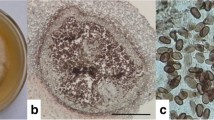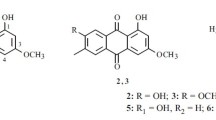Abstract
Fusarium sp. S-435 produces a group of related antifungal antibiotics. Three components of a mixture were isolated in a pure state from the mycelium and cultivation medium of the productive strain: ramihyphins A, B and C. Another two components (D and E) were demonstrated by thin-layer chromatography. Ramihyphin A is the main component of the mixture. Its basic physical and chemical properties are presented. The antibiotic is not active against bacteria, yeast-like microorganisms, oomycetes and several protozoa. It inhibits the growth of higher filamentous fungi, stimulating ramification of hyphae when used at subfungistatic concentration. Ramihyphin A does not inhibit germination of conidia of sensitive fungi but stops their growth after their germination.Blastomyces dermatitidis, Coccidioides immitis andHistoplasma capsulatum belong to most sensitive pathogenic fungiin vitro. Ramihyphin A inhibits considerably the growth of the following phytopathogenic fungi:Stereum hirsutum, Neurospora sitophila, Botrytis cinerea, Monilia fructigena andAlternaria tenuis. The antibiotic exhibits antifungal effects alsoin vivo and is relatively little toxic for HeLa cells.
Similar content being viewed by others
References
Baráthová H., Betina V., Nemec P.: Morphological changes induced in fungi by antibiotics.Folia Microbiol. 14, 475 (1969).
Betina V., Baráth Z.: Bioautographic detection of antibiotics in preparative thin-layer chromatography.J. Antibiot. SerA 17, 127 (1969).
Betina V., Betinová M., Kutková M.: Effect of cyanein on growth and morphology of pathogenic fungi.Arch. Microbiol. 55, 1 (1966).
Horáková K., Drobnica L'., Nemec P., Kristian P., Antoš K., Martvoň A.: Cytotoxic and cancerostatic activity of isothiocyanates and related compounds. III. The effect of stilbene, azobenzene and polycondensed aromatic hydrocarbon ITC derivatives on HeLa cells.Neoplasma 16, 231 (1969).
Hüter R., Keller-Schierlein W., Nüsch J., Zähner H.: Stoffwechselprodukte von Mikroorganismen. 48. Mitteilung. Scopamycine.Arch. Mikrobiol. 51, 1 (1965).
Nemec P., Betina V., Bačíková D., Baráth Z., Betinová M., Rusinko, M., Takáčová Ž.: Antibacterial, antifungal, antiprotozoal and antinematodal activity of microscopic fungi isolated from soils in Indonesia.J. Antibiot., Ser.A 17, 140 (1964).
Nemec P., Križková L., Balan J., Balanová J., Kutková M.: Incidence of antiprotozoal and antivermal antibiotics in fungi. I. ClassFungi imperfecti.J. Antibiot. 22, 345 (1969).
Turner W. B.: Fungal Metabolites. Academic Press London, 1971.
Author information
Authors and Affiliations
Rights and permissions
About this article
Cite this article
Baráth, Z., Baráthová, H., Betina, V. et al. Ramihyphins—Antifungal and morphogenic antibiotics fromFusarium sp. S-435. Folia Microbiol 19, 507–511 (1974). https://doi.org/10.1007/BF02872917
Received:
Issue Date:
DOI: https://doi.org/10.1007/BF02872917




